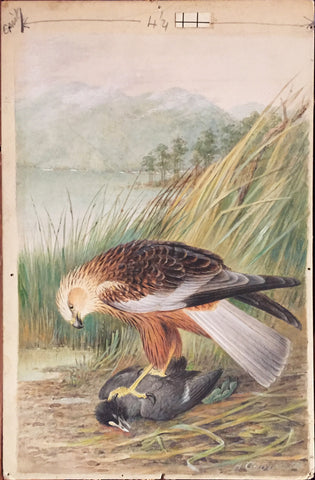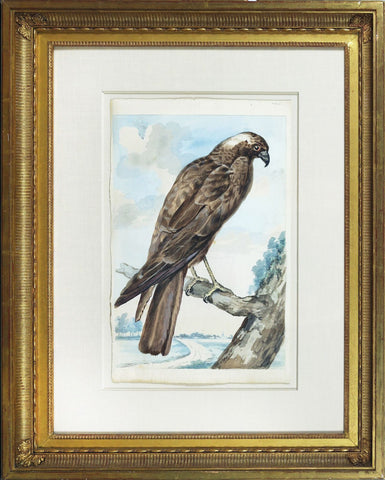
Henrik Grönvold (Danish, 1858 –1940), Circus Ruginosus (Marsh Harrier)
Henrik Grönvold (Danish, 1858 –1940)
“Circus Ruginosus (Marsh Harrier)”
Prepared for Plate XIII W.H. Hudson and L. Gardiner, Rare, Vanishing and Lost British Birds (1923)
Pencil and watercolor heightened with gouache, some with touches of gum Arabic on paper
Signed ‘H Gronvold’ l.r.
1922-1923
Paper size: 10 1/4 x 6 3/4 in.
Provenance: Anonymous sale; Christie’s, London, 17 March 1999, lot 149, private collector.
“Marsh Harrier, Ruff and Reeve, and Hen Harrier came to the end of their existence as British birds almost simultaneously. Harriers are birds of the open moorland and marsh, and nest on the ground; it follows that in a country where no interval of mercy, or Close Time, is extended to birds of prey, they are less able to escape destruction than the species which nest in cliffs and trees—Falcons, Kites, and Buzzards. Of Harriers we possessed three species, and of these the Marsh, the largest of the three, was the first to vanish. It was once a regular breeder, abundant in the fen district, and not uncommon in suitable localities throughout the British Islands, and particularly common in Ireland. Ornithological writers of half a century ago wrote of it as not yet quite extinct, since a few pairs still bred, or tried to breed, in the Broads district of Norfolk. I think that since that date the British race has long become extinct; but there are certain migratory species which re-appear at frequent intervals after the original race has ceased to exist, and the Marsh Harrier is one of these. It had practically died out, or been exterminated, in the seventies, but a few pairs are often seen, and a few have bred in Norfolk of late years. In 1899, for instance, a nest ready for eggs was found, but the two birds were shot, and Mr. J. H. Gurney reported in his Ornithological Notes for the county in 1900 that none had bred since 1894. Adult birds which would have nested were shot in May and June, 1905 and 1906. In 1915 and 1919 single pairs were stated to have brought off young successfully on one of the Broads where such visitors are rigorously protected. But these are casual visitors, and elsewhere the Marsh Harrier occurs but as a rare vagrant in autumn and winter seasons. As an inhabitant of swamp and marsh, no doubt its numbers were gradually diminished by cultivation and drainage, but it is safe to say that but for the keeper and collector the species would survive to-day in many districts well suited to its habits. At one time it was plentiful in the New Forest; in Somerset it seems to have lingered until the seventies; and in the fifties it still bred in Cornwall.
Willughby, writing of the bird by its old name of More or Moor Buzzard, speaks of it as ‘common to be seen in Heaths and Wastes; sitting upon small trees and shrubs’ and ‘said to build in Fenny places.’ Hancock, in Birds of Northumberland and Durham (1873), wrote:
‘A few years ago common on swampy moorlands, where it bred, it has now almost disappeared under the policy of the game-preserver, and is fallen, or is fast falling, from the rank of a resident to that of a mere casual visitant. In 1823 I took a nest of it, with four eggs, on the moors at Wemmergill, near Middleton-on-Tees, the shooting-box of the late Lord Strathmore. Both parent birds had been trapped or shot by the gamekeeper, and formed part of his museum, nailed against the stable- walls. This collection was made up of Hawks, Owls, Daws, Buzzards, and such like ‘vermin,’ both biped and quadruped, being altogether one of the largest and most disgusting I have ever seen. It is now quite impossible in the north of England for any gamekeeper to form such another museum to bear testimony to his zeal and ignorance, as the so-called vermin no longer exist.’
Mr. Dresser (Birds of Europe ) says: ‘In Wales, Suffolk, Cambridgeshire, Huntingdonshire, Lincolnshire, and the counties from Yorkshire northward, it has become historical.’
In 1889 Mr. Howard Saunders (Manual of British Birds) wrote:
‘The Marsh Harrier is now all but banished from the number of our indigenous birds. ... At the present day a pair or two, probably colonists from Holland, almost annually attempt to rear their broods in the Broads district of Norfolk, but are rarely if ever allowed to succeed; and I know of no other county in which this Harrier has recently nested. . . . Statements respecting its breeding in Aberdeenshire, Banffshire, etc., are simply incredible. Ireland offers many more congenial situations, and the bird was formerly common. . . . Since 1840 the keepers have nearly succeeded in exterminating it by the use of poison.’
That any Harriers survive in Irish wilds is not known. The keepers have now wholly succeeded; guns, traps, and poison have given this graceful and interesting Hawk his quietus.
‘The Marsh Harrier has not yet been quite exterminated from the British Islands. It still breeds in the
Norfolk Broads and in Devonshire, and occasionally escapes the gamekeeper’s gun in other parts of the kingdom. In Scotland it is still more local.’— Seebohm’s British Birds.
‘Formerly nested abundantly in many of the marshy districts of England, but owing partly to the drainage of the fens, though chiefly to the destruction by gamekeepers, it has now ceased to do so. In Ireland, according to Messrs. Ussher and Warren, it still breeds in Queen’s County, where it is preserved, and in Galway, but elsewhere it has been exterminated.’— Dresser’s Eggs of the Birds of Europe.
‘In the British Isles, where the bird at one time nested in suitable places in England and Ireland, it is now best known as a rare spring and autumn visitor, though a few pairs still nest, or attempt to nest, in Norfolk and the wildest bogs in Ireland.’— Coward’s Birds of the British Isles.
‘Professor Newton, in the latest edition of Yarrell, issued in 1874, says that “ the birds breed regularly in Devonshire, Norfolk, and Aberdeenshire; and Mr. Dixon, in his Nests and Eggs of British Birds, issued just twenty years after, says that Norfolk is the only county in Great Britain in which the bird regularly attempts to breed. This is one among many of the facts which serve to illustrate the rapidity with which our rarer birds are being banished.’— Kearton, British Birds’ Nests.”
HENRIK GRÖNVOLD (DANISH, 1858 –1940)
Henrik Grönvold studied drawing in Copenhagen and worked first as a draughtsman of the Royal Danish Army’s artillery and an illustrator at the Biological Research Station of Copenhagen. In 1892, Grönvold left Denmark for London, employed at the Natural History Museum preparing anatomical specimens. There he became a skilled taxidermist and established a reputation as an artist. He was employed at the Museum until 1895 when he accompanied William Ogilvie-Grant on an expedition to the Salvage Islands. After this expedition, Grönvold worked at the Museum in an unofficial capacity as an artist for decades and only left London to attend an ornithological congress in Berlin.
Grönvold’s illustrations mainly appeared in scientific periodicals such as the Proceedings and Transactions of the Zoological Society, The Ibis, and the Avicultural Magazine. In these publications, he drew plates for William Ogilvie-Grant, George Albert Boulenger, and Michael Rogers Oldfield Thomas, among others. Grönvold also completed numerous plates for Walter Rothschild, many of which appeared in Rothschild’s journal Novitates Zoologicae. Grönvold mostly illustrated birds and eggs, rare and newly discovered species from many parts of the world, and mostly worked in lithographs.
Among the books, Grönvold illustrated is George Shelley’s Birds of Africa, which contained 57 plates, many of which had not been illustrated before. He illustrated W. L. Buller’s books on the birds of New Zealand, Brabourne’s Birds of South America, Henry Eliot Howard’s The British Warblers (1907–14), Charles William Beebe’s A Monograph of the Pheasants (1918–22), and Herbert Christopher Robinson’s The Birds of the Malay Peninsula (1929–76). He completed 600 hand-colored plates for twelve volumes of The Birds of Australia (1910–27) by Gregory Macalister Mathews. Grönvold subsequently provided numerous illustrations for Mathews’ The Birds of Norfolk and Lord Howe Islands … (1928) and A Supplement to The Birds of Norfolk and Lord Howe Islands … (1936).
ORIGINAL WATERCOLORS FOR RARE, VANISHING
AND LOST BRITISH BIRDS
by Henrik Grönvold for William Henry Hudson
William Henry Hudson (1841-1922) was a naturalist, author, and staunch advocate for avian preservation and conservancy. Hudson’s lifelong commitment to protecting the environment stemmed from his youth in Argentina, where he marveled at the beauty of nature, spending endless hours watching the drama of forest and field unfold before him. This idyllic upbringing was beautifully penned in the artist’s work Far Away and Long Ago (1918), which remains a cult favorite amongst many novelists, including Ernest Hemingway, who wrote that Hudson’s book was a must-read for any young writer.
Hudson gravitated to studying birds, which guided his life’s work as an ornithologist and author of numerous tomes on the subject. When he settled in England in 1874, he joined the numerous societies for naturalists of the period and became a founding member of the Royal Society to protect birds.
In 1894, W.H. Hudson produced a leaflet titled Lost British Birds produced for Society for the Protection of Birds. Its purpose was to shed light on thirteen “lost” birds which he defined as those “which no longer breed in this country and visit our shores only as rare stragglers, or, bi-annually, in their migrations to and from their breeding areas on the continent Europe,” to concretely show the effect of industrialism, game hunting, and fashion on the sustainability of certain bird species. This pamphlet was illustrated with 15 rudimentary black and white line drawings by A.D. McCormick. Almost immediately after producing his brochure, Hudson began to collect notes for a future publication that would elaborate upon and update facts on endangered and extinct bird species.
Hudson spent the nineteen-teens and early twenties preparing his next publication. When his notes were organized, and he tapped the celebrated ornithological painter Henrik Grönvold (1858-1940) to produce a sophisticated full-color composition for each bird he intended to discuss at length. However, Hudson suddenly died in 1922 before the publication could come to fruition. Hudson’s colleague, Linda Gardiner, pushed the project forward to see it through in 1923.
Please feel free to contact us with questions by phone at 215.735.8811,
or by email at loricohen@aradergalleries.
We Also Recommend





